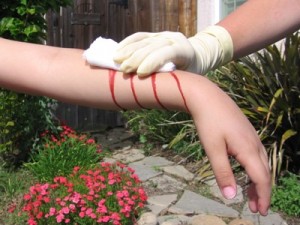The proper use of dressings and bandages are essential first aid skills for treating open wounds and fractures. These skills are taught in basic first aid training courses offered by St Mark James.
Basic rules for use of dressing
Dressing is any material that is applied to a wound with the aim to control bleeding and prevent possible infection. Dressings must be sterile but in emergency situations where sterile dressings are not available, any clean, soft cloth may be used as substitute for dressing.
When applying dressing, you must remember the following basic rules:
- Use sterile or very clean materials as dressings. Avoid touching the part/s of the dressing that will directly come into contact with the wound. If possible, wash your hands with soap and water before handling the dressing but this should not delay providing emergency care. If using pre-packed dressings, grasp it from the corner of the protective pack and place over the wound.
- Cover the entire wound and its immediate surrounding areas.
- Control bleeding. Before applying bandage, make sure the dressing has effectively controlled the bleeding. Continue to apply dressing and manual pressure until bleeding has stopped.
- Do not remove dressing once it has been applied to a wound. Removing the dressing may restart bleeding and even injure surrounding tissues. If bleeding continues, put new dressings on top of the blood-soaked dressings.
- However, if bleeding persists despite bulky dressing, the bulky blood-soaked dressings may be removed to allow reestablishing of pressure.
Basic rules for use of bandage
Bandage is any material that is used to hold the dressing in place and provides pressure to the wound. Unlike dressings, bandages may not be sterile.
When applying bandage, you must remember the following basic rules:
- Not too tight but not too loose. All dressings must be held snugly in place, but the bandage should not be too constricting that it restricts blood flow to the affected part. The bandage should hold the dressing snugly so that it does not slip or move around the wound.
- Do not leave loose ends as they can get caught on objects when the victim moves. Common loose ends include that of tape, gauze and cloth.
- Leave the tips of fingers and toes uncovered. The fingers and toes must be exposed, if possible, to observe changes in skin color that may indicate possible problems with circulation, as well as to allow easier neurologic assessment. Pale, pain or bluish-colored skin all indicate too tight bandage. However, if the digits are burned, they should be covered.
- Cover all edges of the dressing to reduce possible contamination.
- It is best to apply bandage to a large area of the extremity to ensure uniform pressure.
There are different bandaging techniques that are used for specific types of injuries. To learn more about these skills, you should consider completing basic first aid training course offered by St Mark James. Contact your local St Mark James chapter for training schedules.
Related Articles


No reminders of correct or appropriate direction of ,especially limb bandages. For example, leg bandages
Applied from below up, After legs have been elevated,
Best from within , out. Depending on purpose of bandage. That is to apply when edematous legs , for
Instance , are first drained of fluid by posture or elevation. If legs are swollen the bandage will merely
hold the edema in the limb so apply bandage after limb has been drained by elevation ie rest in bed, check and re apply when needed. Otherwise inept
bandaging can make edematous limbs worse.